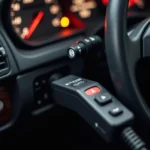OBD2 scanners are essential tools for car owners and mechanics alike, allowing them to diagnose and troubleshoot vehicle issues efficiently. One of the lesser-known but equally important features of these scanners is the OBD2 scanner mode 10, which provides access to vital information about emissions-related systems. This comprehensive guide delves into the intricacies of OBD2 scanner mode 10, explaining its functions, benefits, and how to use it effectively.
 OBD2 Scanner Mode 10 Dashboard
OBD2 Scanner Mode 10 Dashboard
What is OBD2 Scanner Mode 10?
OBD2, which stands for On-Board Diagnostics II, is a standardized system that allows external devices, such as scanners, to communicate with a vehicle’s computer. This system categorizes diagnostic information into various modes, each with a specific purpose. Mode 10, often referred to as “Permanent Emission Codes,” focuses on retrieving stored emission-related data.
Unlike other modes that display real-time data or pending codes, mode 10 stores information about emissions-related faults that have occurred over a more extended period. This data remains stored even after the vehicle’s onboard computer has cleared the check engine light.
Why is OBD2 Scanner Mode 10 Important?
Understanding the significance of OBD2 scanner mode 10 is crucial for anyone who owns or works on vehicles. Here are some key reasons why this mode is essential:
-
Identifying Persistent Emission Issues: Mode 10 allows you to pinpoint recurring emissions problems that might not be immediately evident through other diagnostic methods. This is especially helpful if your check engine light has been intermittently illuminating.
-
Passing Emission Tests: In many regions, passing emissions tests is mandatory for vehicle registration. Mode 10 data can help identify potential issues that might cause your vehicle to fail the test, allowing you to address them beforehand.
-
Evaluating Vehicle Health: The data retrieved through mode 10 can provide insights into the overall health of your vehicle’s emissions system, allowing you to make informed decisions about maintenance and repairs.
How to Use OBD2 Scanner Mode 10
Using OBD2 scanner mode 10 is a relatively straightforward process:
-
Connect Your OBD2 Scanner: Locate your vehicle’s OBD2 port, usually found under the dashboard on the driver’s side. Connect your OBD2 scanner to the port.
-
Turn on the Ignition: Turn your vehicle’s ignition to the “on” position but do not start the engine. This will power up the OBD2 system and allow the scanner to communicate with the vehicle’s computer.
-
Access Mode 10: Navigate through your scanner’s menu options to find and select “Mode 10” or “Permanent Emission Codes.” The exact wording may vary depending on the scanner model.
-
Retrieve and Interpret Data: The scanner will display a list of stored emission-related codes and data. Refer to your scanner’s user manual or an online OBD2 code database to interpret the meaning of each code.
Common OBD2 Scanner Mode 10 Codes
While the specific codes and their interpretations can vary between vehicle makes and models, here are a few common OBD2 scanner mode 10 codes:
- P0420: Catalyst System Efficiency Below Threshold (Bank 1)
- P0442: Evaporative Emission Control System Leak Detected (Small Leak)
- P0138: O2 Sensor Circuit High Voltage (Bank 1, Sensor 2)
- P0300: Random/Multiple Cylinder Misfire Detected
- P0171: System Too Lean (Bank 1)
It’s important to note that these codes provide a general indication of potential issues. Further diagnosis might be required to pinpoint the exact cause of the problem.
Tips for Using OBD2 Scanner Mode 10 Effectively
-
Consult a Mechanic: While interpreting basic OBD2 codes is possible, seeking professional help from a qualified mechanic is recommended for complex issues.
-
Regular Checks: Conduct periodic checks using mode 10, even if your check engine light isn’t illuminated. This can help identify potential issues early on.
-
Quality Scanner: Invest in a reputable OBD2 scanner from a trusted brand to ensure accurate readings and reliable performance.
Conclusion
OBD2 scanner mode 10 provides invaluable insights into your vehicle’s emissions system, empowering you to maintain optimal performance and comply with environmental regulations. By understanding its functions and utilizing it effectively, you can contribute to a cleaner environment while ensuring a smooth and efficient driving experience. Remember to consult a qualified mechanic for any persistent or complex issues related to your vehicle’s emissions system.

